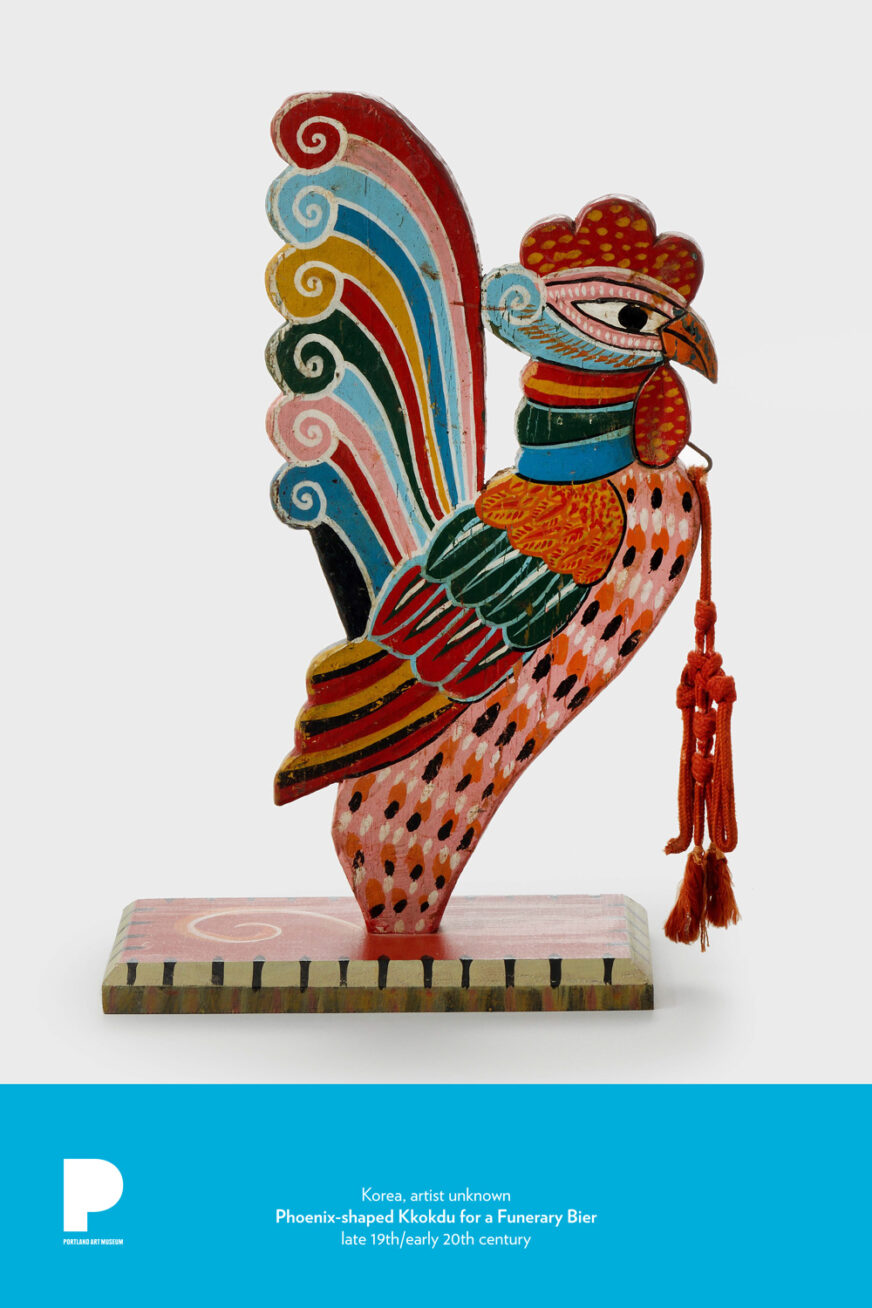
This colorful wooden bird represents a phoenix in the form of a kkokdu (꼭두 pronounced “coke-tu”). Kkokdu are decorative figurines for traditional Korean funerary biers, structures used to carry the deceased to the burial site. These figurines were made in diverse shapes of people and animals meant to guard, entertain, and celebrate the deceased person on their journey to the next life. This cultural tradition has a long history in Korea dating back to the sixth century, and most early kkokdu would have been burnt with the bier after the burial of the deceased. Therefore, most of the surviving pieces date from the late 1800s to early 1900s, like this phoenix-shaped kkokdu.
When this kkokdu was created, it would probably have been one small part of a bier intended to travel through the village from the home of the deceased to their final resting place in a cemetery. The funeral bier, known as sangyeo (상여), would shelter the deceased person’s coffin, but also accompany them to their final resting place in a spirit of celebration and protection. The biers themselves could be magnificent, multi-level structures, requiring two dozen men to carry them.
Most kkokdu were carved in the shape of humans. Usually they were entertainers, like acrobats, clowns, and musicians. Many animal kkokdu were also popular. Dragons and tigers offered protection as fierce guardians, and birds like phoenixes and cranes symbolized taking flight from one world to another. Phoenixes would usually be placed at the very top of the bier, often at the four corners of the roof. They would act as a symbol of transcendence and rising to heaven, guiding souls from this world to the next.
The bright, colorful paint and lively decoration of kkokdu figures also tell us that there was a high value placed on sending off the departed souls in an environment of joy. This phoenix kkokdu has a slender, vertical shape overall; stands more than 1 foot tall; and is carved and painted to accentuate graceful, organic curves. Its body is painted in dots of black, orange, and white pigments on a pink ground. Its wings, head, neck, and tail are even more vibrantly painted, in strong hues of red, yellow, green, blue, and pink with accents of white and other contrasting colors. By repeating shapes in different colors, the painter of this kkokdu has created a strongly patterned, graphic effect, which would have made the decoration eye-catching even from a distance. The phoenix’s multicolor tail feathers suggest the shape of rising flames, or perhaps the stems of plants unfurling toward the sky.
Phoenix kkokdu often had bells or tassels attached, which were decorative but also added an element of sound or movement and could help ensure the bier was moved carefully on its journey. This kkokdu has a red tassel hanging from its neck.
The burial practices that included kkokdu reached their height in the late Joseon period (1392–1897) and declined following the Japanese occupation in 1910. Kkokdu have drawn attention in recent decades through the efforts of collectors who have sought to make kkokdu and Korean traditional culture better known. One such collector is Dr. Kim Ockrang, who began collecting the figurines in the 1970s and founded the Kokdu Museum in Seoul to house her collection of over 20,000 kkokdu.
Discussion and activities
- Spend several minutes looking closely at the phoenix kkokdu. Write down all of the colors you see. Create a drawing. What do you notice about its shapes and patterns? How does the tassel change the figure? How would the phoenix look if it took flight? If you found this object and didn’t know its history, what would you imagine its purpose was?
- Kkokdu have been described as “companions for the journey to the other world.” Traditionally, kkokdu represented real and imagined animals, such as phoenixes, cranes, dragons, and tigers. Many also portrayed human entertainers, such as acrobats and musicians. What kind of creature or person would you choose to accompany your spirit on its journey? What qualities would you like them to have? Create a drawing, painting, or sculpture of your companion.
- The collector Kim Ockrang describes kkokdu as “a tribute to our ancestors’ optimism and humor.” People who are not Korean or are unfamiliar with this tradition may express surprise at how colorful and cheerful the funerary objects appear. The Fowler Museum at UCLA presents them as expressing a “characteristically Korean attitude towards death. Though the kkokdu’s gaiety seems incongruous with mourning, they express a culture’s deep desire that the dead enter the next world surrounded by joy—and its appreciation of the fleeting nature of all experience.”
- Kkokdu provide an opportunity to reflect on how different cultures approach death and burial. How does your family or community honor and mourn the dead? Do art and music play a role in the ceremonies? Is there a place for joy and celebration as well as sorrow? Why might it be important to some cultures that “the dead enter the next world surrounded by joy”?